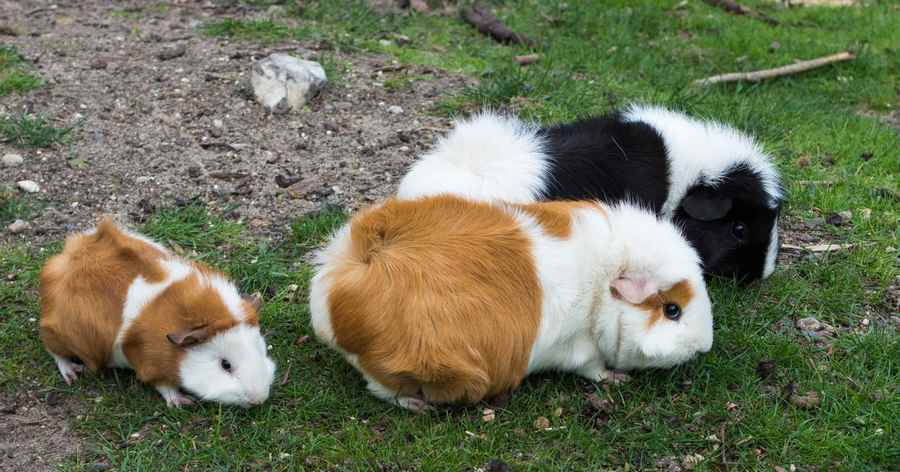Many rodents are kept as pets, like rats, gerbils, hamsters, and guinea pigs. While all of these can be great choices as a pet, guinea pigs are one of the better choices.
They are often misunderstood, which most rodent pets are, but they truly are exceptional pets.
Many people assume that guinea pigs just sit in their cages all day, however, these adorable rodents have big personalities and can be quite engaging.
Moreover, it is interesting to learn more about them as well! This is particularly true for their offspring!
What Do You Do With Baby Guinea Pigs?
It is no secret that the animal kingdom is known for its wide variety of adorable baby animals. Just about every baby animal is super adorable and this is especially true for guinea pigs.
Guinea pig babies are called “pups” when they are born and are birthed into litters. The babies shouldn’t be separated from their mothers for at least a month. Even then, they must be handled very gently. Guinea pigs are fragile animals at any age but especially during their early days of life.
The mothers are generally very protective of their babies during this time. If it is necessary to hold them for some reason, it is important that they shouldn’t be held or touched for at least a week.
Considering that you shouldn’t handle a guinea pig for at least a month after birth, many people question what to do with baby guinea pigs. Guinea pigs need things like veggies and hay.
It is important to let the mother guinea pig show the babies how to eat solid foods like fresh veggies. Guinea pigs will nurse with their mothers after 24 hours from birth and will be ready to eat solid foods after 3 days.
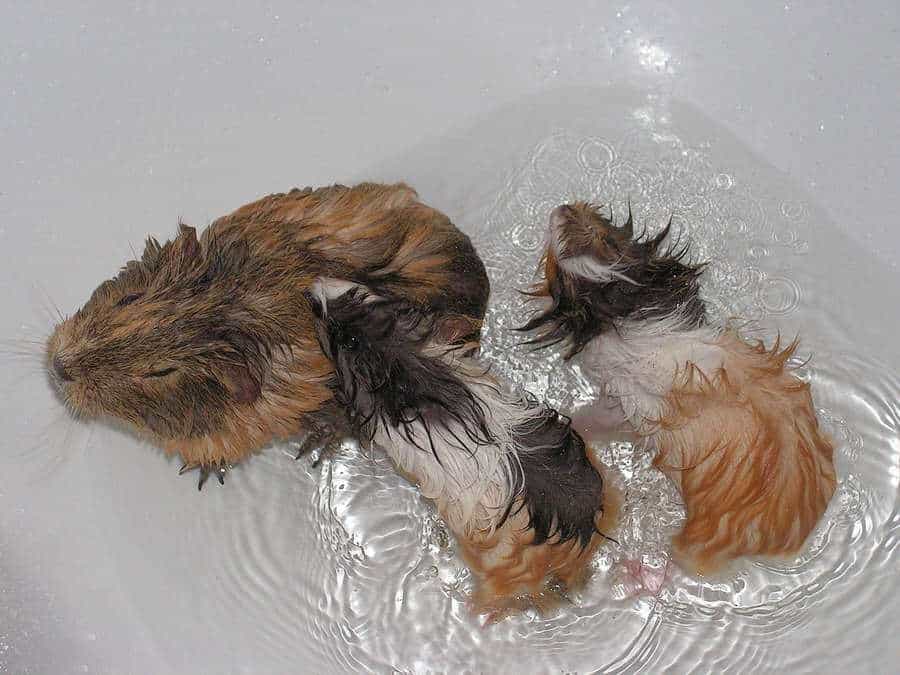
This is an important thing to do as baby guinea pigs need to learn how to do the normal things of a guinea pig. During the month period, the mother guinea pig will teach them a lot, such as scratching and proper cleaning.
While this month is crucial, it is also important to not just ignore them. As expressed, they can be handled after a week, though cautiously. The babies can be picked up, just not separated from their mothers.
The separation is what causes distress in their development. When picking up a baby guinea pig, it is important to always wash your hands first. If they seem skittish, don’t force them to be picked up. Just give them time, as they need to get used to human interaction.
Baby guinea pigs should be held similarly to how older piggies are held. Their feet should always be supported. Because baby guinea pigs are so small, they will generally fit in the palm of the hand.
The other hand should be used to support their bottoms as this makes them feel safe. Even using a small fluffy blanket is a good idea as it provides warmth and also makes them feel safe.
When a baby guinea pig is ready to be picked up, trying to hold them a little every day (after that initial week) is the best way to get them used to human interaction.
Guinea pigs are prey animals and their instinct is to hide. Starting early with getting them used to humans is never a bad idea.
It is important to note that handling a baby guinea pig will not make the mother piggie reject her young like other species of animals. They should not be disturbed during the birthing process and once again, for about a week after birthing.
Baby guinea pigs are ready to leave their mothers after about a month. At this point, they can be put in their own cage environments and treated much like older guinea pigs.
Providing them with ample cage space, hideaways like huts or plastic castles, chew toys (for their teeth that constantly grow!), fresh veggies, hay, and their daily vitamin c are all essential parts of getting a baby guinea pig on its path to growing up comfortably!
Guinea pigs grow quite quickly. In fact, they age pretty quickly like many other rodents. They after often considered adults around 6 months and up to 5 years.
Getting a guinea pig around 2 to 3 months is the best age to get them. This is right after they’ve spent time with their mothers learning how to be a guinea pig and still leaves plenty of time for pet owners to watch them grow up.
As they grow up, they begin to showcase their personalities! All guinea pigs have things that they like. Some love mini plush dog toys to snuggle with, blankets, chew toys that rattle, and even specific treats.
A new guinea pig pet owner will learn what their guinea pigs like the most from having them at a younger age. However, even older piggies showcase their likes and dislikes.
Baby guinea pigs tend to “popcorn“ more than older piggies. Watching them do this is truly amusing and super adorable.
Popcorning is when a guinea pig is super excited about something and jumps into the air, resembling a piece of popcorn popping.
They also do what is called “zoomies” where they run really fast around their cages or a room when they are excited or happy as well.
Another fun thing that baby guinea pigs do is that they “wheek” more than adult piggies.
Wheeking is the noise that they make, which sounds exactly as it is spelled when they are excited or even when they are hungry and want something.
Between learning to hold a guinea pig and figuring out what their personalities are going to be, there are plenty of things to do with a baby guinea pig!
How Many Babies Will A Guinea Pig Have?
As expressed, baby guineas are referred to as “pups”. Generally, a litter of pups will be around 2 to 4 pups but there can be as many as 8. Mother guinea pigs can have up to 5 litters a year! That is an incredible amount of guinea pig babies!
It is important to keep female and male guinea pigs apart while she is giving birth so that there isn’t another chance of her getting immediately pregnant.
This is to prevent any undue stress on the female guinea pig but also so that she has the proper time to spend with her current litter of pups.
The gestation period of guinea pigs, or the amount of time a female guinea pig will be pregnant until birth, is said to be between 59 to 72 days.
This is similar to other animal species, though certain species could be shorter or longer. Either way, up to 72 days isn’t a terribly long time. It is important to note that guinea pig babies can be born prematurely.
Every living species on earth can be born earlier than expected and as a result, they are often smaller in size because they aren’t as developed as a full-term baby.
Just like other animals in the animal kingdom, female guinea pigs can reject premature babies. This isn’t too common, yet it truly depends on how premature the baby is.
If the baby isn’t able to latch on to drink milk, they might be rejected. These guinea pigs can be saved, even if they are rejected by their mothers.
Under the guidance of an exotic pet vet, which usually specialise in rodent care, a premature baby can be nursed to become a strong piggie.
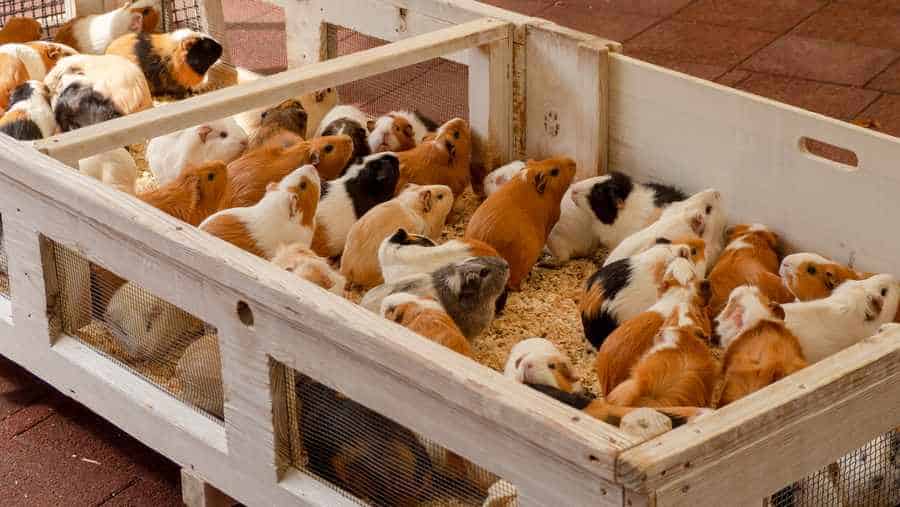
Do Guinea Pigs Kill Their Babies?
Some animals in the animal kingdom will kill their young for a variety of reasons. The most common reason among them is usually because the offspring are sick or undeveloped. When it comes to guinea pigs, they aren’t generally known for killing their young.
However, it is not out of the realm of possibility.
When a guinea pig is born prematurely, the mother guinea pig will simply ignore it rather than kill it.
In the case that a mother guinea pig has killed her young, there are only two reasons behind this action. The first is that the baby was sick or had something wrong with it.
Guinea pigs are known for being silently ill and not showing any outward signs except for not eating or drinking.
However, mother piggies can sense a problem with her young and it is possible that she will kill a baby if she feels it is sick.
The second reason behind a guinea pig killing or eating her young is that she is extremely hungry. With the proper care of a guinea pig, this really shouldn’t be an issue.
Guinea pigs tend to eat more than people realise. Ultimately, guinea pigs should have 1 cup of veggies a day, split up between twice a day servings.
For pregnant piggies, they should have twice the amount of food to ensure that they getting enough.
While the amount of food should increase for a pregnant guinea pig, so should the vitamin c intake. Vitamin c is essential for guinea pigs because their bodies cannot synthesize it.
They need supplemental vitamin c which keeps them healthy and strong. There are two ways to administer vitamin c, either through a dropper syringe with liquid vitamin c or compressed hay tablets with added vitamin c.
Most guinea pigs will prefer the tablets over the liquid. This extra dose of vitamin c will also help a pregnant piggie stay healthy.
These basic steps are critical in making sure that a pregnant piggie is healthy throughout her pregnancy.
If these additional steps are provided, it is less likely that they will harm their young as they won’t feel hungry or deprived of nutrients.
More importantly, the pregnant guinea pig should receive alfalfa hay in place of her timothy hay as it provides even healthier nutrients that are needed for her pregnancy.
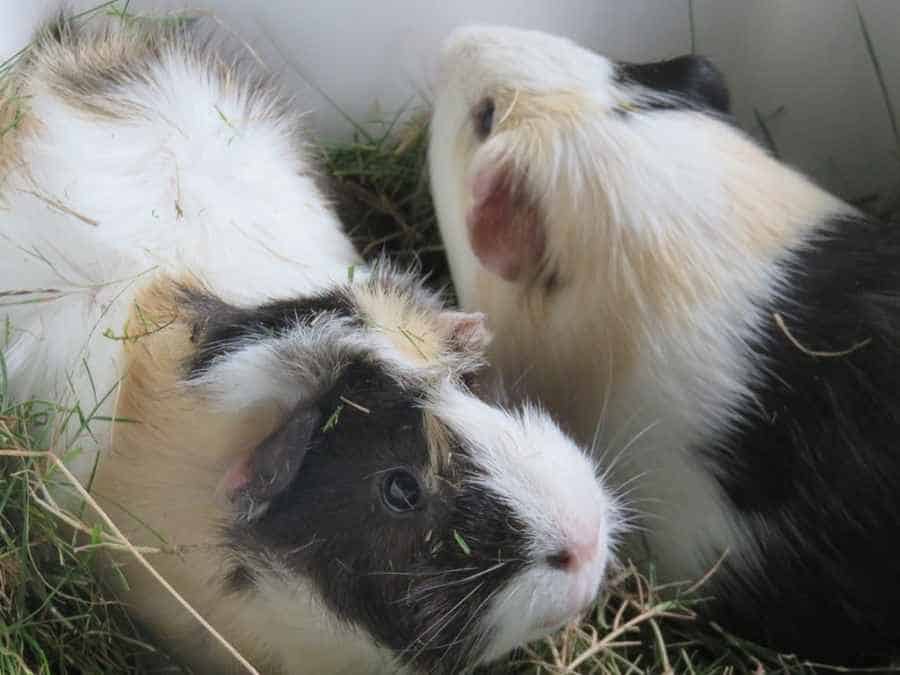
Will Male Guinea Pigs Kill Their Babies?
When other animals in the animal kingdom eat or kill their young, the babies still have some development to do. Every newborn is different in its appearance and functionality.
In the case of guinea pigs, newborns are born with their teeth, hair, etc, and can begin moving almost immediately. Their eyes are open and they can see perfectly fine.
Because of this, guinea pig babies are a little more aware of their surroundings and their instinct to flee is there from birth.
Male guinea pigs aren’t as aggressive as other rodents or other animals in the animal kingdom. With this said, they aren’t known to kill their offspring. However, there are some things to keep in mind about male guinea pigs and their offspring to ensure everyone is kept healthy and safe.
Below are the top concerns to consider of male guinea pigs and their babies
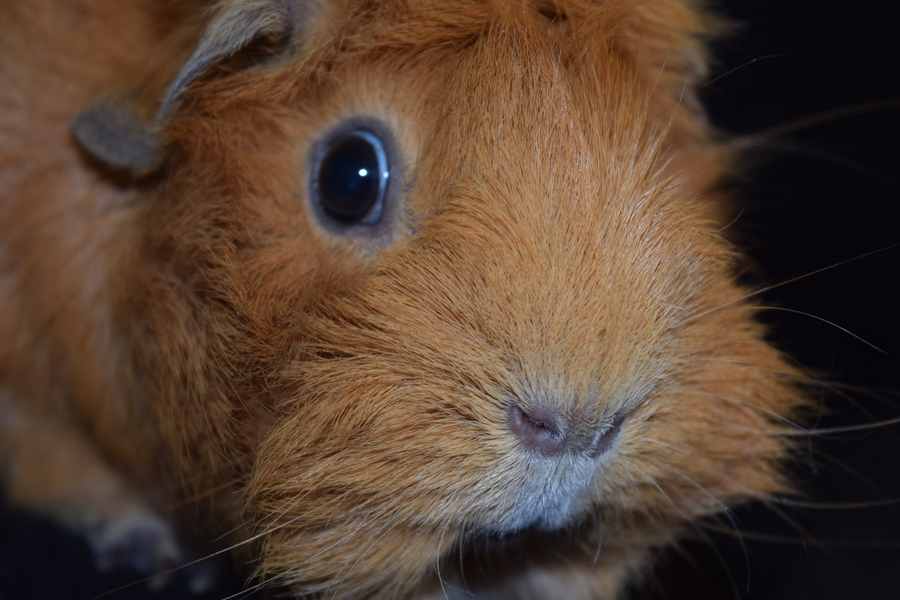
Remove Male Guinea Pigs From The Mother Guinea Pig
Separating male guinea pigs from the guinea pig mother ensures that they aren’t trying to get them pregnant again.
Moreover, this separation allows for the mother to properly care for the guinea pig babies during that month which is so critical to their overall development.
Male Guinea Pigs Can Get Female Offspring Pregnant
Guinea pigs can reproduce around 3 weeks of age. Male guinea pigs might try to reproduce with their female offspring, which is not good considering the size of the guinea pigs.
While this is uncomfortable to think about, it is necessary to remember it so that male guinea pigs are separated from their babies immediately.
While they can be reintroduced to the piggies after around 21 days, it should still be done cautiously and with supervision.
Male Guinea Pigs Can Be Aggressive With Male Offspring
Another reason to separate male guinea pig dads from their babies is that they can be aggressive towards male piggies. Male guinea pigs often referred to as “boars”, are known for showing dominance.
This dominance can be shown between dads and sons, brothers, or two male pigs who don’t know each other. It is important to note that this “aggression” isn’t as severe as other rodents or animals.
Usually, it refers to the males attempting to mount each other and nipping. While it is possible to have two male guinea pigs together, it generally doesn’t work out as expected.
For the safety of the piggies, guinea pig dads should be kept away from their offspring and mates. Not only does it keep everyone safer, but it also ensures that no unwanted pregnancies occur again.
What Are Some Fun Facts About Baby Guinea Pigs?
Guinea pigs are absolutely amazing pets! They are intelligent, engaging, and interesting rodents to keep as pets.
But what are some fun facts about guinea pigs and baby guinea pigs? Below are some fun facts about these adorable creatures!
Fun Facts About Baby Guinea Pigs (And Guinea Pigs In General!)
- Baby guinea pigs can start running at only 3 hours old!
- Male baby guinea pigs can reproduce early, somewhere around 9 weeks of age, and are fully sexually mature around 4 months.
- Guinea pigs eat their own poop. Certain poop that guinea pigs produce have nutrients that are critical for them. Mother guinea pigs tend to create these poops to feed her young during the first month that she is teaching them.
- A guinea pig’s teeth are constantly growing, even baby piggies after birth. Because of this, it is important that they have access to wooden chew toys and hay to help grind their teeth down.
- Baby guinea pigs are called “pups”, male piggies are called “boars”, and female piggies are called “sows”.
- Guinea pigs have 4 toes on their front feet and only three on their back feet! Their back feet are a little longer than their front feet.
- Guinea pigs don’t sweat! Baby and adult guinea pigs alike do not sweat. Because of this, hotter temperatures can cause them to have heat strokes.
- Baby guinea pigs are only about 3 to 6 inches in length (or 7 to 15cm)!
- At birth, guinea pigs are only about 60 to 120 grams. Throughout life, they grow to be around 680 grams (1.5lbs) to 1179 grams (2.6lbs).
- Guinea pigs are born with all their teeth and fur and with their eyes open!
- Guinea pigs have 258 bones! While there are a lot of bones for such a small creature, they are incredibly delicate. Newborns should always be carefully handled but so should guinea pigs of any age!
Baby guinea pigs are simply adorable. As a guinea pig grows, they become even more adorable! While it is a good idea to get a baby guinea pig around 2 months of age, guinea pigs, in general, do have a basic life stage, just like other animals.
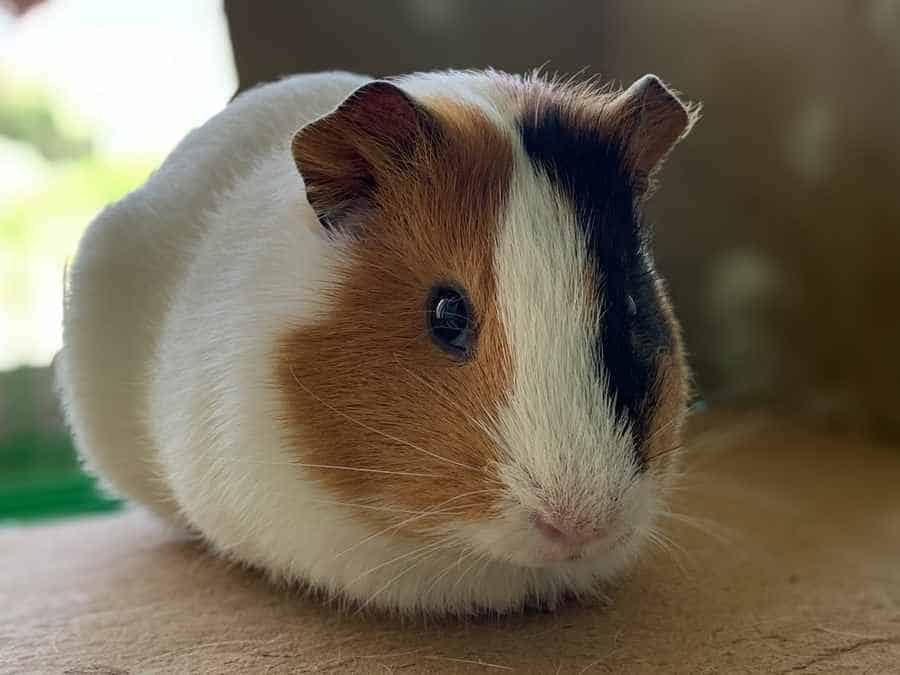
Below Is The Life Cycle Of A Guinea Pig
| Young/Baby guinea pig | Adult guinea pigs | Senior guinea pigs |
| Birth – 6 months of age | 6 months – 5 years of age | 5 years of age and older |
These three basic life stages of a guinea pig are important because, during each of these stages, guinea pigs need certain things to help them grow and keep them at their healthiest.
Young guinea pigs need alfalfa-based food that provides them with important nutrients for their growing bodies. Guinea pigs grow faster than other animals so it is important that they have what they need.
Adult guinea pigs need timothy-based food and hay products to help out during this stage of their life.
As they approach the senior status of age, closer to age 5 and above, they might slow down a little bit. In this case, they need to be encouraged to exercise.
Exercise for any guinea pig should be daily and older piggies will need help. This can be done by encouraging them with their favourite toys, veggies, or treats.
Senior piggies really start to slow down. As long as their droppings appear normal (pellet shaped and firm) and they are still eating and drinking, they are doing alright.
Exercise should be encouraged just as it is with adult guinea pigs by offering them some of their favorite things. Their diet could be similar to adult piggies.
However, they may have special needs such as additional vitamin c in their diets.
Guinea pigs are interesting creatures and pets no matter their age but baby guinea pigs are truly fascinating. Not only are they interesting but so are their lives before they are separated from their mothers!
While these rodents are often misunderstood, they can make the perfect pet for those looking to have an engaging animal with a big personality!
Recent Posts
Guinea pigs are one of the world's most unique and adorable rodent pets. These creatures have such large personalities and are often misunderstood. Having a guinea pig as a pet comes with...
Getting a guinea pig for a pet is such an exciting experience! These adorable rodents are quirky pets that are really fun to engage with. Guinea pigs have a reputation of being boring, however, this...


